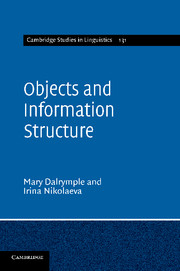Book contents
- Frontmatter
- Contents
- Preface and Acknowledgements
- List of Abbreviations
- 1 Introduction
- 2 Syntactic assumptions
- 3 Information structure in grammar
- 4 Syntax and information structure
- 5 Topicality and grammatical marking
- 6 Topical marking of nonsubjects
- 7 Topicality and DOM
- 8 Primary and secondary objecthood and DOM
- 9 Multiple objects and grammatical alignment
- 10 Semantic features, topicality and grammaticalisation
- 11 Conclusion
- References
- Author Index
- Language Index
- Subject Index
9 - Multiple objects and grammatical alignment
Published online by Cambridge University Press: 05 October 2012
- Frontmatter
- Contents
- Preface and Acknowledgements
- List of Abbreviations
- 1 Introduction
- 2 Syntactic assumptions
- 3 Information structure in grammar
- 4 Syntax and information structure
- 5 Topicality and grammatical marking
- 6 Topical marking of nonsubjects
- 7 Topicality and DOM
- 8 Primary and secondary objecthood and DOM
- 9 Multiple objects and grammatical alignment
- 10 Semantic features, topicality and grammaticalisation
- 11 Conclusion
- References
- Author Index
- Language Index
- Subject Index
Summary
Although the syntax of ditransitives and verbs with multiple complements is not the main focus of this book, we offer here some general observations on multiple object constructions in languages with DOM, and a review of alignment possibilities involving grammatical function, information-structure role, semantic role, and grammatical marking for monotransitive and multitransitive verbs. For a thorough discussion of double object constructions in an LFG setting, see Börjars and Vincent (2008) and Lam (2008).
On the typology of multitransitive constructions
In Chapter 2, Section 2.2, we reviewed the classic LFG theory of grammatical functions, which includes a distinction between primary and secondary objects, originally called OBJ and OBJ2 (Bresnan 1980, Kaplan and Bresnan 1982). The theory was subsequently refined by Bresnan and Kanerva (1989), who proposed to replace the OBJ/OBJ2 distinction with a distinction between the primary object OBJ and the family of secondary object functions OBJθ.
The primary/secondary object distinction is also explored by Dryer (1986), who proposes a rough typology of argument linking patterns with trivalent verbs like ‘give’, which take a theme and a goal. Dryer distinguishes two classes of ‘give’-type constructions. His first class draws the traditional distinction between a theme direct object and a goal indirect object; in LFG, this would be analysed as involving an OBJ theme and an oblique goal (OBLGOAL), as in (1a). This alignment pattern has also been referred to as “indirective”. Dryer's second class distinguishes primary and secondary objects (OBJ vs. OBJTHEME), as in (1b).
- Type
- Chapter
- Information
- Objects and Information Structure , pp. 169 - 193Publisher: Cambridge University PressPrint publication year: 2011



